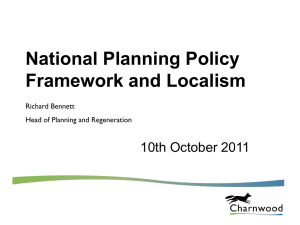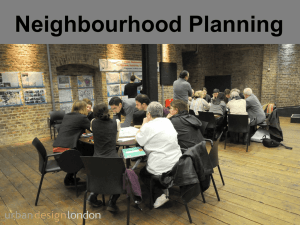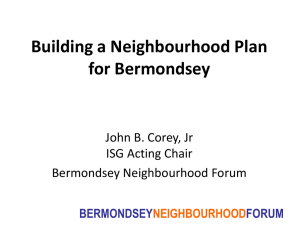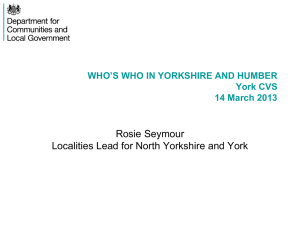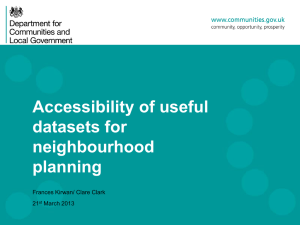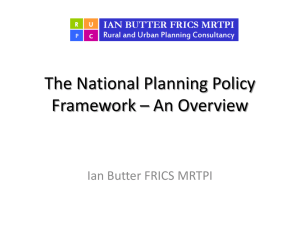Encouraging greater public participation in planning following the
advertisement
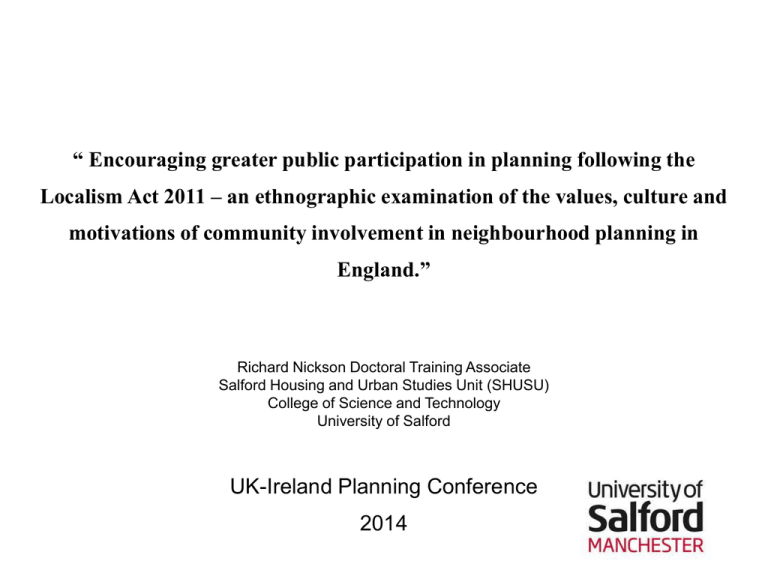
“ Encouraging greater public participation in planning following the Localism Act 2011 – an ethnographic examination of the values, culture and motivations of community involvement in neighbourhood planning in England.” Richard Nickson Doctoral Training Associate Salford Housing and Urban Studies Unit (SHUSU) College of Science and Technology University of Salford UK-Ireland Planning Conference 2014 Contents • What is neighbourhood planning and what does it do? • Research Aim • Research Objectives • The DCLG hypothesis for neighbourhood planning • The current position • Development of the research methodology • Emerging findings from the perspective of a participantobserver, interviews and discussion forum What is a neighbourhood plan? • A “new way” (according to Government) for local communities to influence what goes on in their locality. • An element of the modified planning system which the Government see as essential for economic growth, by increasing the rate of house building • Brought about by the Localism Act 2011. • Regulated by the National Planning Policy Framework, replaced over 1000 pages of planning guidance and regulation, with 50 pages. • Delivered by groups of volunteers drawn from the locality preparing the plan. What does a neighbourhood plan do? • Forms part of the spatial plan for development of an area, alongside the Local Plan. • The Local Plan is prepared by the Local Planning Authority and the Neighbourhood Plan could be prepared by either: • A neighbourhood forum (of 24 local community volunteers), or, • A community steering group forming a sub-committee of a second or third tier local government organisation specifically Parish or Town Council (PTC). • There is no definition of the constitution of a community steering group. • You cannot form a neighbourhood forum in an area with a PTC. • The Neighbourhood Plan can allocate development sites, and, form development control policies. It carries weight and must be considered in granting planning permission for development. Areas of opportunity to make a contribution to knowledge • Planning and sustainable urban (re)development (SUD) operate in the prevailing political, social and economic context of the country of reference. • Neighbourhood planning is a new concept in the creation of the spatial plan for a locality - there is not a significant body of research on this particular topic. • Concept of community participation in planning is not new – but the new system may represent a new paradigm for planning. • This study provides an opportunity to examine such activities from the perspective of a participant using ethnographic techniques. • The researcher is a participant observer. Research Aim “To understand how communities develop neighbourhood plans, and in doing so examine the impact of the Localism Act 2011 in terms of its likelihood to increase community engagement and participation in planning and urban regeneration” Research objectives • Explore the policy context for the study. • Identify appropriate study areas and understand organisational approaches towards neighbourhood planning in the study areas. • Assess the capacity of community groups in the study areas. • Identify individual motivations for participation within the study population and to compare these to national data. • Measure the degree to which a study population feel that they can influence decisions in their local area. The DCLG hypothesis Encouraging signs? The current position in England • 1183 applications for NP status • 856 designated • 69 submitted for approval • 38 Examined • 23 Adopted • Numerous legal challenges and local controversy – examples in Cheshire West and Tower Hamlets • Reducing rate of take up / completions? Data as at 28/8/14 – Planning Magazine online Development Plan Tracker. Reality on the ground north west England Growth in Neighbourhood Planning showing signs of slowing down? Development of the research methodology 1 • Initially an action research project in Salford using elements of the Localism Act to move forward community involvement in planning. A scoping exercise revealed little support for such a process in Salford. • An opportunity for the researcher to participate in a neighbourhood plan in his home town emerged, during the Autumn of 2012. • The number of neighbourhood plan areas growing from 17 in late 2011, 210 underway in mid 2012 to over 700 by mid 2013, now 850+ in 2014. • This expanding population raised concerns about the scale and usefulness of elements of the original plan for a questionnaire based survey – particularly given the researcher’s interest in understand the values and beliefs of participants. Development of the research methodology 2 • A mixed methods, qualitative approach was called for to address the developing research objectives. • Participant – observation was established in the Neston neighbourhood plan • A small scale pilot questionnaire was circulated amongst a sample of neighbourhood plan areas, revealing potentially useful study participants within a small group of case study locations. • Other work, including web-based discussion groups, Governmental research seminars and dialogue with active participants led the researcher to adopt an ethnographic approach. • Alongside participant-observation a series of semi-structured interviews, a field diary and web based discussions now forms the bulk of research data. • Thematic analysis will be applied to develop a ‘thick’ descriptive narrative The participant observer (me) • I am a member of the Neston Neighbourhood plan community steering group; involves: attending meetings, public events, knowledge exchanges and reading / researching local issues and discussion papers. • Chair of community consultation sub-group (lapsed) • Member of Quality of Life and Transport sub-group (ongoing) • Background in sustainable transport planning, highways development control, strategic and local plan making, professionally qualified, extensive experience in local government and private practice. • Engaged as a researcher by UoS and working towards submission of PhD thesis (3rd year) Motivations Place attachment – personal, social, emotional, financial – civic pride “many people don’t realise the efforts we make” Organisational / reputational – poor experiences with previous plan-led approaches, lack of faith local and national governmental effectiveness Cultural – the majority of participants are habitual volunteers – “if I don’t do it – who will?” Sceptism of politics – local and national – no desire to participate in political arguments, many pragmatists and those keen to “see something happen” – “if WE don’t what will the future look like”. Backgrounds – high level business, public sector, academic – many having achieved change in former careers, now with “time on their hands” – but a clear desire to “give something back” Observations • Length of time is a barrier to commitment – a war of attrition for volunteers – many move on or away during the process. e.g. Neston Plan is two years plus and counting. A Cheshire East Councillor recently stated in a planning committee that, in respect of the refusal of a housing proposal, that “its okay, because the Parish Council has just decided to develop a NP, and, they hope to have it in place by spring, and that plan will have other housing proposals in it, so we can make this decision.” • Complexity of requirements: - the evidence base, “creeping professionalism”, and, “hoop jumping” all cited as off putting to many who rely on local knowledge and personal judgement. • A lack of tangible outcomes in short term frustrates “activists” who want to “do something”, even if in an unplanned manner. Emerging theoretical conclusions NP – is an emerging form of collaborative governance (CG), but can it develop a new planning paradigm – bottom up, community led, locally sustainable – examined by Healey, Davoudi inter alia. NP - an example of Common Pool Resource management (CPRM), inspired by the works of Poteete, Ostrom, et al: the organisational models developed here can provide guidance for effective delivery of NP. See also Susser and Tonnelat – Transformative Cities, The three urban commons. We need to better understand Place Identity, Volunteerism and community organisational capacity linked to application of models arising from CG and CPRM theory, in developing the wider adoption of NP as a practice. But without financial backing, organisational support and reduced bureaucracy then it seems that NP may struggle to have far reaching impact. Currently it is not having significant impact on planning decisions for the majority of the population. Planners as ethnographers can explore this emerging “movement either through action (research) or participation / observation. Thank you Contact: r.nickson@edu.salford.ac.uk Supervisor: Prof. Phil Brown Useful references: Carley, M. Jenkins, P and Smith, H (2001) Urban Development and Civil Society, the role of communities in sustainable cities, London: Earthscan Davoudi, S (2013) Localism and neo-liberal governmentalism, Town Planning REVIEW, 2013, 84(5) 551-561 Maginn, PJ (2007) Towards more effective community participation in urban regeneration: the potential of collaborative planning and applied ethnography. Qualitative Research February 2007 vol7: pg 25-43 Poteete, AR. Janssen, MA and Ostrom, E (2010) Working Together, Collective Action, the commons and Multiple Methods in Practice. Princeton University Press, Princeton

